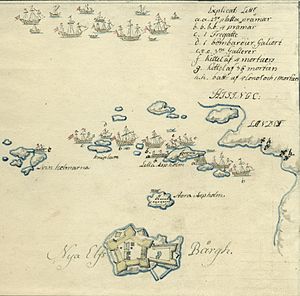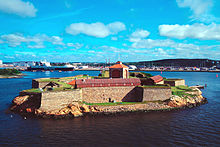Attack on Gothenburg (1719)
| date | July 20, 1719 - September 27, 1719 |
|---|---|
| place | Gothenburg , Sweden |
| output | Swedish victory |
| Parties to the conflict | |
|---|---|
| Commander | |
| Troop strength | |
| 360 soldiers 80 cannons 3 galleys 2nd attack 100 soldiers 100 cannons |
6000 soldiers 528 cannons 20 vers. Boats 2nd attack 30 soldiers |
| losses | |
|
30 dead and 70 wounded |
60 dead and 73 wounded |
1st phase: Swedish dominance (1700–1709)
Riga I • Jungfernhof • Varja • Pühhajoggi • Narva • Pechora • Düna • Rauge • Erastfer • Hummelshof • Embach • Tartu • Narva II • Wesenberg I • Wesenberg II
Arkhangelsk • Lake Ladoga • Nöteborg • Nyenschanz • Neva • Systerbäck • Petersburg • Vyborg I • Porvoo • Neva II • Koporje II • Kolkanpää
Vilnius • Salads • Jacobstadt • Walled Courtyard • Mitau • Grodno I • Olkieniki • Nyaswisch • Klezk • Ljachavichy
Klissow • Pułtusk • Thorn • Lemberg • Warsaw • Posen • Punitz • Tillendorf • Rakowitz • Praga • Fraustadt • Kalisch
Grodno II • Golovchin • Moljatitschi • Rajowka • Lesnaja • Desna • Baturyn • Koniecpol • Weprik • Opischnja • Krasnokutsk • Sokolki • Poltava I • Poltava II
2nd phase: Sweden on the defensive (1710–1721)
Riga II • Vyborg II • Pernau • Kexholm • Reval • Hogland • Pälkäne • Storkyro • Nyslott • Hanko
Helsingborg • Køge Bay • Gulf of Bothnia • Frederikshald I • Dynekilen Fjord • Gothenburg I • Strömstad • Trondheim • Frederikshald II • Marstrand • Ösel • Gothenburg II • Södra Stäket • Grönham • Sundsvall
Elbing • Wismar I • Lübow • Stralsund I • Greifswalder Bodden I • Stade • Rügen • Gadebusch • Altona • Tönning II • Stettin • Fehmarn • Wismar II • Stralsund II • Jasmund • Peenemünde • Greifswalder Bodden II • Stresow
The renewed attack on Gothenburg in 1719 was a military intervention in the Great Northern War . The Danish captain Peter Wessel Tordenskiold tried on July 21, 1719 to destroy the Nya Elfsborg and to conquer the port of Gothenburg and Gothenburg himself.
In advance
After the surrender to the Swedes in Marstrand , with almost the entire Gothenburg squadron sunk, the Danish captain Peter Wessel Tordenskiold turned to the port city of Gothenburg again. Together with the commander of the Kattegatt fleet, flag captain Oluf Budde , he worked out an attack plan on the fortress and the harbor. This time they attacked Gothenburg with all available ships. The plan was to first take the Nya Elfsborg under massive fire and, if possible, to shut it down completely. Then the port and finally the city should be conquered.
The attack
The Danish attack started on July 21, 1719. The fleet consisted of seven ships of the line , two frigates , four of barges, three bombards and four galleys which had a total of about 528 cannons and about 6,000 crew members.
After an artillery battery had been built on the small island of Aspholmarna opposite the fortress Nya Elfsborg , the Danish fleet positioned itself and began to bombard the fortress.
At the time of the attack, the Swedish crew of the fortress numbered around 360 men from the Elfsborg Regiment. In addition, a Saxon artillery regiment under the command of Johan Abraham Lillie , which was equipped with 80 guns of various calibers, defended the fortress. The artillery was divided into four batteries, these were named: Käringbergets batteri (Hornschotenklee Berg), Caroli batteri, Hisings batteri and Billingen skans
After three days of continuous fire, the damage to the fortress was extensive. The fortress’s gunpowder depot was hit by a direct hit. The force of the subsequent explosion had caused an outer wall of the fortress to collapse. The three-story tower was also badly damaged. Even so, Commander Lillie refused to capitulate. To the Danish offers to hand over the fortress, he replied: Better to be brought back to Gothenburg as a dead Lillie than to be a living Henrich Danckwardt. (Henrich Danckwardt was the commandant of Marstrand, he handed the fortress over to the Danes. He was sentenced to loss of honor, property and life and was executed by cutting off his head in 1720.)
Colonel George Bogislaus Staël von Holstein , commander of the Skaraborg Regiment, began a counterattack from Arendal on July 24th. Arendal is a district in the north-west of Gothenburg, on the island of Hisingen and is closest to the fortress Nya Elfsborg. In this position the Swedes were able to fire directly into the flank of the Danish fleet. The Danish ships suddenly caught in the crossfire broke off the siege of the fortress and withdrew out of range.
Meanwhile, three Swedish galleys left and attacked the mortar battery on the island of Aspholmarna. After a short battle, the guns were captured and the immediate danger to the fortress was averted.
The Danish ships continued to block the access to the city and so all troops in Gothenburg remained on high alert.
At dawn on September 1, a Swedish flotilla set sail from Nya Varvet , a district in the west of Gothenburg. The Swedish ships sailed up the Göta älv . They reached the Baltic Sea via the upper tributary of the river, called Nordre älv, and surprised the Danish fleet. In the attack, a galley, a bombard, two piece subframes and five barges were boarded.
Attack on Nya Varvet
On the night of September 27th came Tordenskjold's revenge, which the Swedes had been waiting for since the attack on the Danish fleet. Under the command of Captain Oluf Budde, nine Danish sailing boats sailed past the Elfsborg Fortress unnoticed and headed for the port of Gothenburg. The order was to recapture lost Danish ships and set fire to the remaining Swedish ships.
While the sailing boats were passing the Käringbergets Battery, the guards discovered them and called them. When asked who they were, the Danes replied that they were good Swedes . This military ruse enabled the Danes to penetrate further into the port. In the approach to the port, her path was crossed by a patrol boat from the Caroli battery. The Danes let the Danes pass without calling, the patrol boat relied on the outposts and saw no danger in the sailing boats.
Once in port, Budde sent Captain Cleves and 30 soldiers to the port watch to take them off. The Danes have been approached by Swedish posts several times over the years. Since these consisted mainly of Saxon soldiers who could not distinguish Swedish from Danish, and the Danes had also turned their uniforms so that the blue inner lining was now on the outside and the uniforms looked very similar to the blue Swedish uniforms, they could pass through all posts.
They crept up the Lilla Billingen , a small hill 20 meters high above the harbor where the harbor guard was stationed. The Danes stormed the building and called out to the twelve Saxon soldiers inside to surrender. The officer on watch, an ensign by the name of Franck, rose and asked in astonishment: What, surrender? . As soon as he had uttered the words, he was shot by Captain Cleves and sank to the ground.
After Captain Budde received the signal that the harbor watch had been rendered harmless, the Danes began setting fire to eight Swedish ships and scuttling them. Then they left the harbor with two captured galleys.
In the meantime a Saxon soldier had managed to escape from the Lilla Billingen and alert the Swedes. The batteries were occupied and the Danes came under fire. This suffered only minimal losses and the captain Budde was able to flee with the captured galleys.
losses
The losses in the first attack on Nya Elfsborg Fortress were 30 dead and 70 wounded on the Swedish side and 60 dead and 73 wounded on the Danish side.
For the second attack on the port there is no precise information on casualties or wounded.
The consequences
The Danish fleet withdrew and Gothenburg was accessible again for merchant ships. These attacks on Gothenburg were the last armed conflict between Sweden and Denmark in the great Nordic War.
For his services in the battle for Gothenburg, Georg Bogislaus Staël von Holstein was appointed major general in 1720 and was given command of the life guard of Karl Friedrich von Holstein-Gottorf .
After the Peace of Frederiksborg on July 23, 1720 Tordenskiold took a leave of absence and ended his active military service in the Danish Navy.
Individual evidence
literature
- Entry in the Runeberg project


